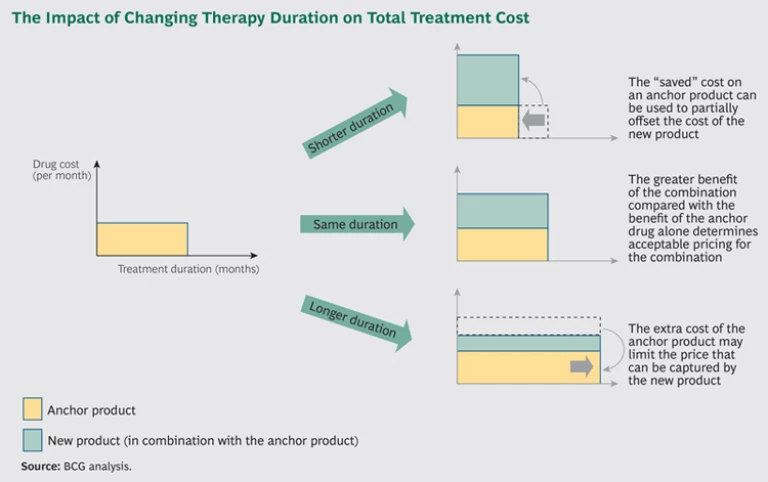The role of combination therapies in medicine continues to grow. For the treatment of HIV/AIDS, cancer, and hepatitis C, pharmaceutical companies are increasingly seeking approval for combination treatments—in many cases, entering crowded markets. That’s one reason why setting prices for these combinations is exceedingly complex. Pricing decisions require an analysis of multiple known factors, including time left under patent protection and potential market size, as well as an assessment of a host of unknown events, including the outcomes of pending clinical trials for products in the combination and for competing products, and the future pricing strategies of competitors.
Pricing combination treatments is a new challenge that requires a systematic approach to evaluating the numerous interconnected issues that come into play. The key is to understand how each development or pricing decision impacts current and future prospects for the therapies—and to set prices on the basis of that comprehensive view. In most cases, the goal will be to develop a strategy that keeps the company’s pricing options open, allowing for adjustment as events unfold.
An effective pricing strategy is key to securing reimbursement and maximizing the potential of therapies, particularly in developed markets such as Europe and the U.S., where gaining market access is increasingly difficult. And the risk of mismanaging all the trade-offs involved in price setting is significant. According to our estimates, suboptimal pricing may pare as much as 20 percent off the projected sales of a new drug over its life cycle.
The Increasing Prevalence of Combination Therapies
Of course, combination therapies are not new. Oncology’s chemotherapy regimens have often involved multiple drugs. Meanwhile, HIV/AIDS treatments have long required combination drug treatments culminating most recently in Gilead Science’s Stribild, a fixed-dose single-tablet regimen involving a “quad” combination of elvitegravir, cobicistat, tenofovir, and emtricitabine. Other diseases, including hepatitis C and diabetes, also use combination drug treatments.
Such combinations will only become more common in the years ahead. Driving this is the growing understanding of complex disease pathways. Advances in cell biology and genomics have increased the development possibilities of so-called targeted therapies, drugs that inhibit the function of specific molecules within the biological cascade of events that lead to disease. At the same time, it has become increasingly clear that many diseases are caused by multiple factors, making it necessary to interfere in the disease process at more than one point by deploying several targeted therapies.
The work now under way in combating metastatic melanoma illustrates the new wave of targeted combination drugs. Metastatic melanoma, an advanced type of skin cancer, claims more than 50,000 lives per year. Just over three years ago, there was not a single targeted therapy on the market. Today, there are no fewer than ten targeted therapies being considered in various combinations, therapies likely to substantially change patients’ prognostic outlook.
As the potential for innovative combination therapies grows, however, the reimbursement challenges continue to intensify. The situation is particularly acute in Europe, where government-driven austerity is placing ever-increasing pressure on payers to improve their allocation of scarce funding. And even within the U.S., there is a growing willingness to take action against prices deemed unjustifiably high.
The One-Pill Solution
The pricing equation is significantly simpler when the various therapies can be combined in a single dose or pill. In this instance, there is a distinct price for the combination. That combination is treated as a single product, and there is no need to attribute a portion of the price explicitly to the two or more medicines that make up the combination. The upshot: the prices of those individual drugs are not affected. This allows more flexibility in pricing both the individual components that make up the combination therapy and any future combination therapies involving those components.
This approach is well suited to small-molecule drugs that can be combined in fixed doses in a single pill. Such one-pill combinations typically provide not only a boost in effectiveness over a single drug but also contribute to increased patient compliance.
When One Pill Is Not an Option
For most combination therapies, however, developing a single fixed-dose pill is not easy. This may be because at least one of the components is a biologic, the dose needs to be customized on the basis of factors such as weight, or the schedule for taking the various components needs to be varied. Here, the task of establishing a pricing structure becomes exponentially more complex.
The approach is dictated by the company’s starting point and whether both agents in the combination are new, whether one of the elements has a well-established existing market, and how long both components will remain patent protected. Of particular importance is whether the company controls one or both components of the combination. If it controls both pieces, a question is, does the company lower the price of one of them? If the company controls only one piece, does it agree to lower the price on the piece it controls? In that case, is there a risk that the pricing might “spread” from the lower-price drug in the combination to other indications or non-combination treatment settings?
Regardless of those specifics, however, there are three steps to mapping out the right pricing strategy:
- Evaluate the outlook for clinical trials of the combination’s components and of competing products.
- Weigh the impact the combination has on the necessary length of the treatment compared with the duration of treatment required for competing therapies.
- Understand the options for structuring reimbursement, including the possible use of rebates or cost caps.
Evaluate the clinical-trial landscape. A crucial aspect of pricing strategy is what the potential is for the various components of the combination therapy—and for competing products. Assessing this means factoring in possible clinical-trial outcomes and new indications for all these products and then evaluating the impact various pricing decisions would have on both the individual products that make up the combination and the combination therapy itself.
When there are many difficult-to-predict outcomes, pricing should be set to preserve the highest option value down the road. This was the objective in work we conducted recently for a global pharmaceutical company that faced tough pricing decisions on multiple products and a number of combination therapies for which those products were being evaluated. The central pricing-strategy question posed was, should we maximize the price of one or the other components in a combination that is being launched imminently?
To get a handle on all the possibilities, we conducted a comprehensive scenario-based analysis. Taking into account all potential trial outcomes across multiple indications for the individual drugs and combinations, we identified a staggering 900 or more possible scenarios. We ruled out some permutations that were highly unlikely and zeroed in on those that had the highest probability of becoming realities. In the end, we focused on about 20 potential scenarios. For each possibility, quantitative modeling was used to assess how different pricing strategies would play out, highlighting the conditions that would make one pricing strategy superior to another, as well as the risks associated with each.
The process allowed the identification of potentially critical developments and the optimal pricing strategy that would be required should those events materialize. The result was a clear, detailed, and highly adaptable plan.
Weigh the impact the combination has on length of treatment. A central factor in pricing is whether patients should take the combination for less time, the same period, or a longer period than the “anchor” drug—the original drug that had previously been used alone. For example, in oncology, a more effective combination therapy typically extends survival and therefore leads to a longer treatment period. In contrast, a shortened treatment period appears likely in, for example, hepatitis C combination treatments. With these therapies, the treatment time to achieve a sustained virological response—the state in which the virus is undetectable in the blood for six months or more—may decrease from 48, to 24, or even, ultimately, 12 weeks.
Those differences in the length of treatment have major implications for pricing. (See the exhibit below.) Increasingly, payers are evaluating value and cost of treatments in terms of the total period required for treatment—the “episode of care.” If the episode of care is shorter with a combination than with the single anchor drug, the maker of the second, additive drug is in a strong position in terms of pricing: the cost savings generated by reduced use of the anchor drug can essentially pay for some of the cost and, in certain cases, the full cost of the second drug. In some instances, the total cost of treatment may actually be lower for the combination, thanks to that reduced treatment period.
If the treatment period is extended, however, the pricing challenge is greater. That’s because the total cost of the combination treatment is inevitably higher than the cost of treating with the anchor drug alone—if the price of the anchor drug remains unchanged. This is likely to create resistance from payers who want to control costs in the face of constrained budgets.
In addition, there is the issue of sales distribution from the extended use of that anchor agent. If a single company controls both the anchor and the second drug in the combination, it can determine how to price each component to maximize total sales for the company across all uses for those products. But if another company controls the anchor drug, the company providing the second, additive product in the combination will aim to negotiate a deal that allows it to capture some of the revenues generated by the additional use of the anchor.
Complicating this arithmetic is the fact that it is common for payers in different countries to have disparate ways of measuring costs, assessments that are then factored into their price negotiations with pharmaceutical companies. In some countries, such as Poland, comparisons are made on the basis of volume—per vial or per milligram of drug. In others, such as France and Germany, the cost of a drug is considered at fixed intervals—monthly or annually—taking into account dosing differences among patients. Finally some authorities, such as those in Canada and Australia, consider the total cost of treatment for a patient, an approach that factors in differences in the length of treatment.
The result: the increased cost of a new combination therapy compared with the existing alternative therapies varies depending on the measurement approach the payer takes. These differences can lead to different negotiated prices across markets. And as more countries use international reference pricing—the practice of basing drug prices on what they sell for in other nations—it will become critical to understand how a price set in one jurisdiction might spill into other markets.
Understand how reimbursement should be structured. In many cases, if a company controls both components of a combination, the simplest pricing approach is to discount the price of the drug with the weaker sales outlook. But that can introduce other headaches.
For one thing, it reduces future pricing flexibility because in just about every country market, the discount for that drug will always be applied—even if a valuable new use for that product is eventually discovered. In addition, that approach may be less than ideal in situations in which either formal or informal international price-referencing mechanisms could cause those discounts to spread into multiple markets.
There are reimbursement designs that avoid such problems. Companies can maintain individual product prices and establish rebates or caps—caps for any individual patient treated or caps for an entire population—on costs of the combination. Such arrangements will provide payers with protection against out-of-control spending on the combination.
But execution of such arrangements can be problematic. For one thing, the roles that payers and providers play relative to their impact on prescribing decisions and management of drug costs—and the degree to which the operations of those two groups are integrated—vary greatly across markets. The result, in many cases, is that separate deals need to be negotiated with different groups in different regions. Adding to the complexity is the fact that drug treatment involves multiple players—physicians, pharmacies, and payers.
Consequently, information related to pharmaceutical use is rarely collected centrally. So the data needed to calculate what is owed under rebate or cost cap arrangements, such as the number of patients taking a certain drug for a certain condition, may not be readily accessible to the payers.
For payers, which are migrating toward value-based health care, it is critical to address this information gap. The goal is to develop the infrastructure to capture the usage information on all drugs—single or combination—that would enable payment of differentiated prices. Establishing that type of system, however, will require a step change in pricing and reimbursement analytic capabilities.
In our view, the emergence of targeted combination therapies is an inevitable trend that will fundamentally change the paradigm for drug commercialization. Pharmaceutical companies will need to take a more sophisticated approach to their pricing and reimbursement strategies, one that is capable of factoring in the impact of a significant number of variables including major unknowns. The stakes—and the cost of “getting it wrong”—are rising.








